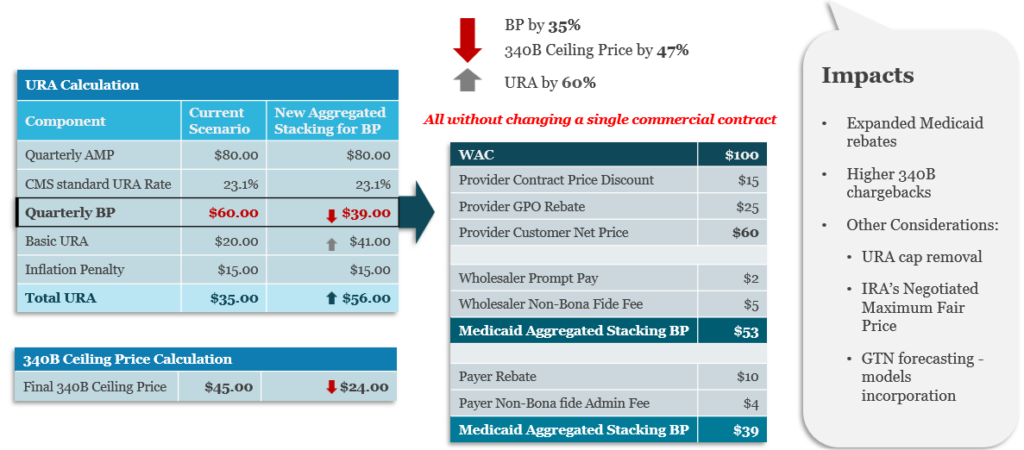MDRP Summit 2023 – Best Price Stacking Proposal

Author’s note: In this article, we summarize our latest conference discussion during Medicaid Drug Rebate Program (MDRP) Summit 2023, on the Best Price Stacking Proposal and its potential implications and considerations for pharmaceutical manufacturers. Should you have any questions or thoughts to share, please feel free to reach out to us, and we would be glad to help you.
Get the copy of the presentation for offline reading or reference: Download PDF
Table of Contents
- US ex rel. Sheldon v. Allergan Sales, LLC
- Medicaid Drug Rebate Program (MDRP) Proposed Rule: Best Price Stacking Proposal
- Operational, Compliance, and Financial Issues with the Stacking Proposal
Sheldon v. Allergan Sales, LLC
MDRP Reasonable Assumptions

- A former employee brought a qui tam action against Forest Laboratories (later merged into Allergan Sales), alleging that Forest defrauded the government by submitting false price reports.
- The relator alleged that Forest violated the price reporting requirements of the MDRP by failing to aggregate all discounts to separate customers within the same chain of distribution when calculating Best Price.
- The relator further alleged that false price calculations lead to inflated Best Price amounts reported to the government, and the underpayment of rebates to the states in violation of the False Claims Act (FCA).
- Forest argued that because CMS’ guidance on cumulative discount calculations was ambiguous, and because it’s interpretation of the ambiguous statute was reasonable, it did not make any false statement or act with the requisite scienter to make a false statement.
- The district court accepted Forest’s argument and granted its motion to dismiss, finding that Forest had acted under “a plausible and objectively reasonable interpretation” of the MDRP statute.
- In reaching its decision, the court pointed to CMS guidance encouraging manufacturers to make reasonable assumptions in calculating Best Price.
- On appeal, the U.S. Fourth Circuit Court of Appeals affirmed the dismissal of the relator’s complaint, finding that Forest’s interpretation was not only objectively reasonable, but also the most natural reading of the Best Price definition.
- The Court also acknowledged that, despite being expressly asked for clarification, CMS had “nonetheless failed to clarify and thereby maintained strategic ambiguity.”
- In September 2022, after a rehearing en banc an equally divided Fourth Circuit issued an order affirming the dismissal of the relator’s complaint by a vote of 7-7.
MDRP Proposed Rule
On May 26, 2023, CMS published the Misclassification of Drugs, Program Administration, and Program Integrity Updates Under the Medicaid Drug Rebate Program Notice for Proposed Rulemaking (i.e., the MDRP Proposed Rule)
CMS proposes to modify the regulatory text at 42 C.F.R. § 447.505(d)(3):
“The manufacturer must adjust the best price for a drug for a rebate period if cumulative discounts, rebates, or other arrangements to best price eligible entities subsequently adjust the price available from the manufacturer. Cumulative discounts, rebates, or other arrangements must be stacked to determine a final price realized by the manufacturer for a covered outpatient drug, including discounts, rebates, or other arrangements provided to different best price eligible entities.”
In other words, CMS proposes that manufacturers “stack” price concessions across customers and channels, also referred to as “follow the pill”
CMS maintains that this proposal is a clarification of its current policy and in part, a response to Sheldon because the court determined that CMS’ regulatory text regarding the stacking requirement was not sufficiently clear.
Litigation Considerations
If CMS finalizes the stacking proposal, manufacturers may legally challenge the Agency. In the meantime, manufacturers may consider the following:
- Comments on the proposed rule preserve and strengthen any court challenge.
- Document reasonable assumptions regarding your company’s ability to track discounts through the supply chain if you must stack.
- Substantive claim that revised regulatory definition is inconsistent with the plain reading of the statutory definition and years of divergent practice.
Operational, Compliance, and Financial Considerations
An Example of How Best Price is Determined Today

Should we give this proposed Best Price approach a name? For the purpose of the article, let’s call this proposed Best Price approach “Aggregated Stacking”
Stacking Best Price: Current vs. Proposed

“Aggregated Stacking” of Multiple Customers for BP

Summary of Impacts
- Huge expansion of the number of “things” that can impact Best Price
- So many uncertainties and practical issues make this arguably impossible.
- If truly required by a Final Rule, how can we start tracking so much more?

Operational Challenges
Potential Approach to Tracking and Determining “Aggregated” Stacking in Best Price
- Need to ensure a clear understanding of the customers who will “touch” the same pill/product.
- What is the Product Path?
- Document these Product Paths and verify the contracts and discounts these BP-eligible customers will achieve (potentially achieve)
- Connect the various discounts for one eligible customer to determine that customer’s net price.
- How do you do this today?
- Manually with spreadsheets by tracking contractual rates?
- Systematically with linkages between data sets or loaded contractual rates?
- How do you do this today?
- Now, we need to link these individual customer discounts across all the eligible customers within the same Product Path
- Reasonable Assumptions would be needed to try and limit the variables.
- Does the “time” it would literally take a product to follow that path come into play?
- Meaning the sale to a wholesaler was in Q1 but the dispense was in Q2.
- What quarter to categorize these discounts in?
- Do we need data from parties in the supply chain to prove a specific product unit traveled through?
- Confidential information in some cases and often simply not feasibly available
- Balance of regulation interpretation (which is undefined) with operational realities.
- Other areas: Best Price True Up process, bundling scenarios, value-based purchasing arrangements, and even processing considerations.
- Does the “time” it would literally take a product to follow that path come into play?
Tracking Aggregated Stacking for Best Price

Operational Challenges: What to do??
- Build an approach to define product paths and then confirm the customers on the path.
- Forced to change our normal perspective on Best Price tracking.
- Leverage automation to combine discounts and customers.
- Ensure reporting provides an opportunity to review and audit/test for known realities of your customer contracts.
- Define clear, reasonable assumptions to bridge the realities of determining “aggregated” stacked Best Price with available data, linking challenges and timeframes.
- Use reports to forecast potential new contracts by plugging in new discounts and measure the impact on overall Best Price.



